1998 PONTIAC GRAND PRIX tire size
[x] Cancel search: tire sizePage 224 of 402

Run your engine only as long as you must. This saves
fuel. When you run the engine, make it
go a little faster
than just idle. That is, push the accelerator slightly. This
uses less fuel for the heat that you get and it keeps the
battery charged. You will need
a well-charged battery to
restart the vehicle, and possibly for signaling later on
with your headlamps. Let the heater
run for a while.
Then, shut the engine off and close the window almost
all the way to preserve the heat. Start the engine again
and repeat this only when you feel really uncomfortable
from the cold. But do it as little as possible. Preserve the
fuel as long as you can.
To help keep warm, you can get
out
of the vehicle and do some fairly vigorous exercises
every half hour or
so until help comes.
Loading Your Vehicle
TIRE - LOADING INFORMATION A
OCCUPANTS
MAX. LOADING @ GVWR SAME
1 1
r
'U
IT, ADD 28KPA (4LBS)
Manual for tire pressure needed at
himlH(100 mph) or higher speeds, where legal, kr nrlrlitinnal tira inlnrmo+inn
Two labels on your vehicle show how much weight it
may properly carry. The Tire-Loading Information label
is on the inside of the trunk lid. The label tells you the
proper size, speed rating and recommended inflation pressures for the tires on your vehicle. It also gives you
important information about the number
of people that
can be in your vehicle and the total weight you can
carry. This weight is called the vehicle capacity weight
and includes the weight
of all occupants, cargo and all
nonfactory-installed options.
4-3 1
Page 271 of 402
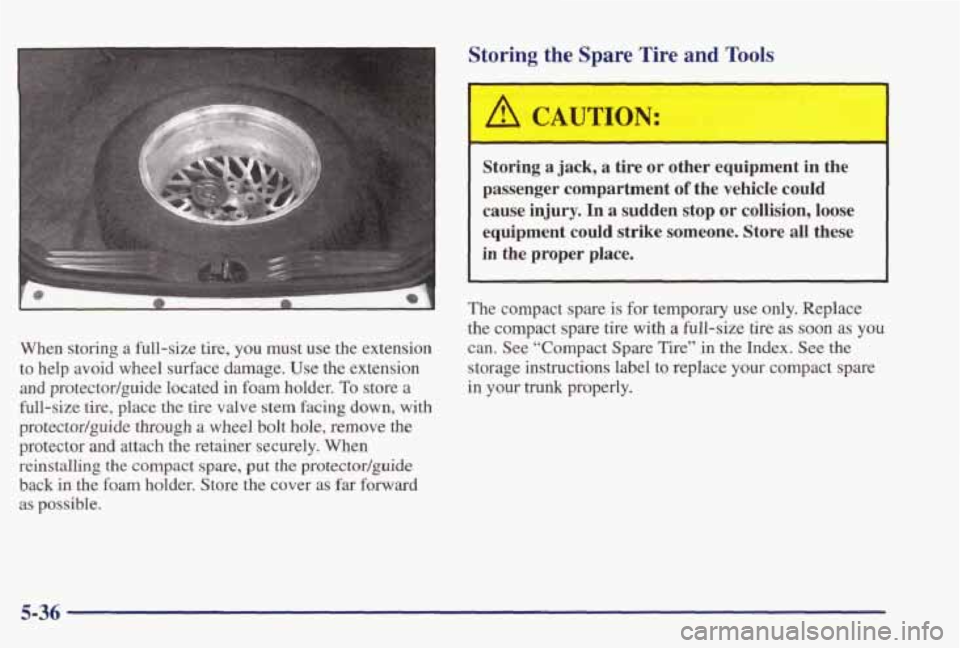
When storing a full-size tire, you must use the extension
to help avoid wheel surface damage. Use
the extension
and protectodguide located in foam holder. To store a
full-size tire, place the tire valve stem facing down, with
protector/guide through a wheel bolt hole, remove
the
protector and attach the retainer securely. When
reinstalling the compact spare, put the protectodguide
back in the foam holder. Store the cover as
far forward
as possible.
Storing the Spare Tire and Tools
I A CAUTION:
Storing a jack, a tire or other equipment in the
passenger compartment
of the vehicle could
cause injury.
In a sudden stop or collision, loose
equipment could strike someone. Store all these
in the proper place.
The compact spare is for temporary use only. Replace
the compact spare tire with
a full-size tire as soon as you
can. See “Compact Spare Tire”
in the Index. See the
storage instructions label to replace your compact spare
in your trunk properly.
5-36
Page 272 of 402
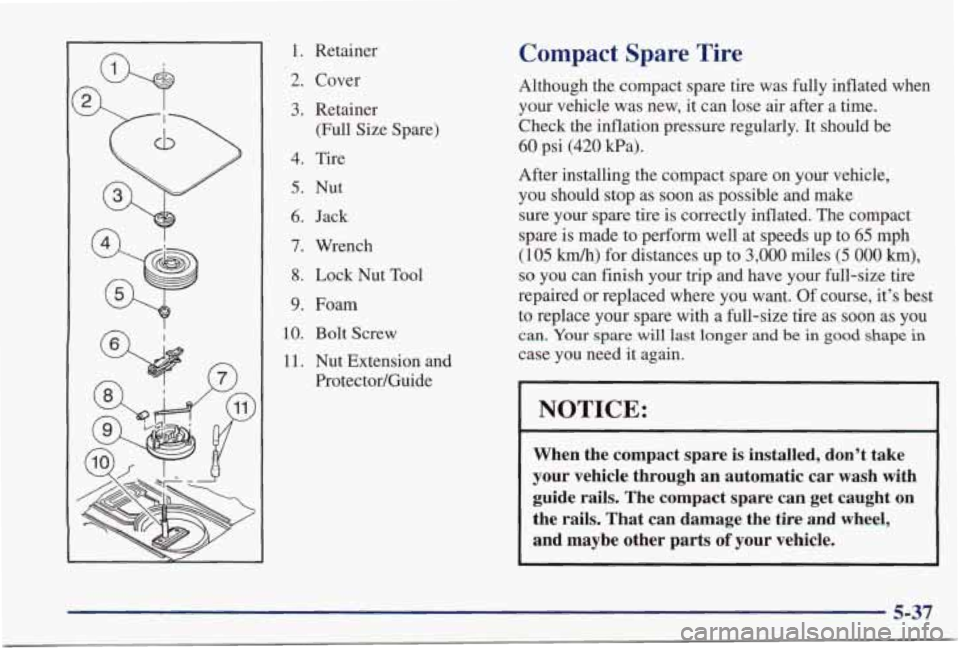
1. Retainer
2. Cover
3. Retainer (Full Size Spare)
4. Tire
5. Nut
6. Jack
7. Wrench
8. Lock Nut Tool
9. Foam
10. Bolt Screw
11. Nut Extension and
Protector/Guide
Compact Spare Tire
Although the compact spare tire was fully inflated when
your vehicle was new,
it can lose air after a time.
Check
the inflation pressure regularly. It should be
60 psi (420 Pa).
After installing the compact spare on your vehicle, you should stop as soon as possible and make
sure your spare
tire is correctly inflated. The compact
spare is made to perform well at speeds up to
65 mph
(105 km/h) for distances up to 3,000 miles (5 000 km),
so you can finish your trip and have your full-size tire
repaired or replaced where you want. Of course, it’s best
to replace your spare with a full-size tire as soon as you
can. Your spare will last longer and be in good shape in
case you need it again.
I I
NOTICE:
When the compact spare is installed, don’t take
your vehicle through an automatic car wash with guide rails. The compact spare can get caught on
the rails. That can damage the tire and wheel,
and maybe other parts
of your vehicle.
5-37
Page 322 of 402
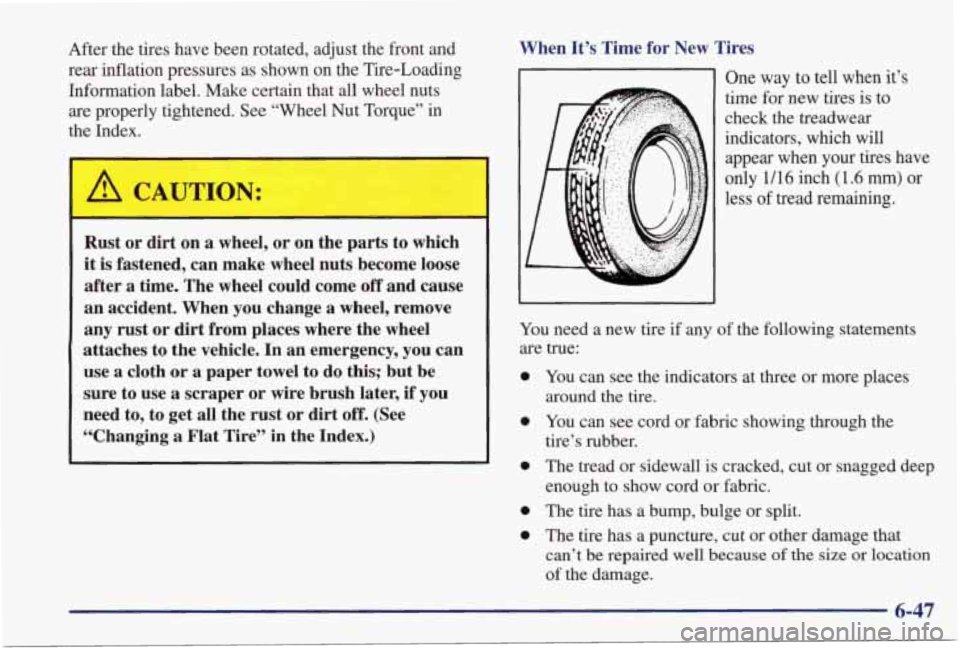
After the tires have been rotated, adjust the front and rear inflation pressures as shown on
the Tire-Loading
Information label. Make certain that all wheel nuts are properly tightened. See “Wheel
Nut Torque” in
the Index.
L
Rust or dirt on a wheel, or on the parts to which
it is fastened, can make wheel nuts become loose
after a time. The wheel could come
off and cause
an accident. When you change a wheel, remove
any rust or
dirt from places where the wheel
attaches to the vehicle. In an emergency, you can
use a cloth or a paper towel to do this; but be
sure to use
a scraper or wire brush later, if you
need to, to get all the rust or dirt
off. (See
“Changing
a Flat Tire” in the Index.)
I I
When It’s Time for New Tires
.. I
One way to tell when it’s
time for
new tires is to
check the treadwear
indicators, which will appear when your tires have
only 1/16 inch (1.6 mm) or
less
of tread remaining.
YOU need a new tire if any of the following statements
are true:
0
0
0
0
0
You can see the indicators at three or more places
around the tire.
You can see cord or fabric showing through the
tire’s rubber.
The tread or sidewall is cracked, cut or snagged deep
enough to show cord or fabric.
The tire has a bump, bulge or split.
The tire has a puncture, cut or other damage that can’t be repaired well
because of the size or location
of the damage.
6-47
Page 323 of 402
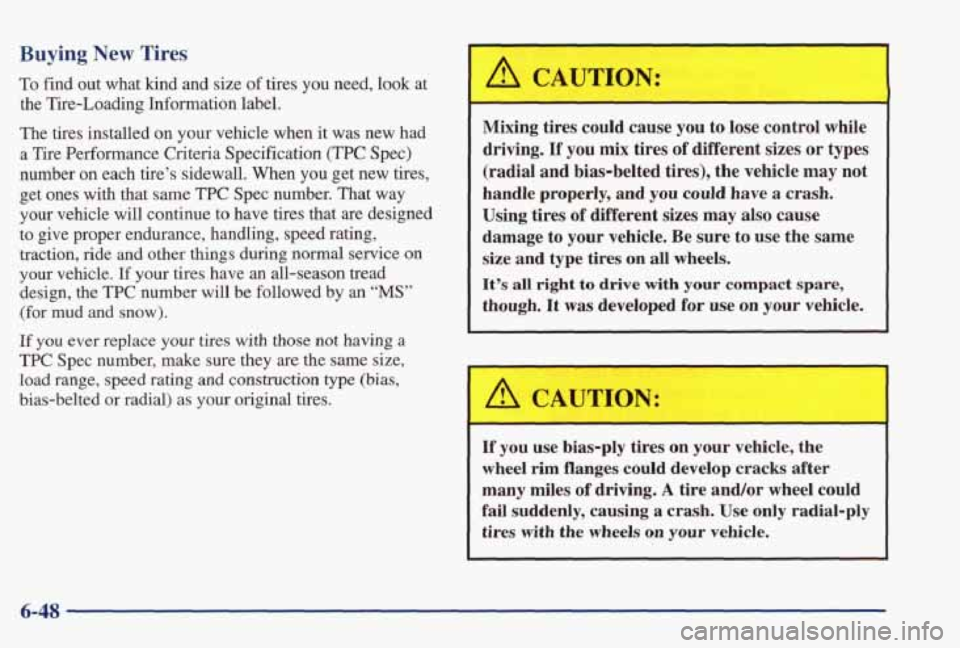
Buying New Tires
To find out what kind and size of tires you need, look at
the Tire-Loading Information label.
The tires installed
on your vehicle when it was new had
a Tire Performance Criteria Specification
(TPC Spec)
number
on each tire’s sidewall. When you get new tires,
get ones with that same TPC Spec number. That way
your vehicle will continue to have tires that are designed
to give proper endurance, handling, speed rating, traction, ride and other things during normal service
on
your vehicle. If your tires have an all-season tread
design, the TPC number will be followed by an
“MS”
(for mud and snow).
If you ever replace your tires with those not having a
TPC Spec number, make sure they are the same size, load range, speed rating and construction type (bias,
bias-belted
or radial) as your original tires.
A CAUTION:
Mixing tires could cause you to lose control while
driving.
If you mix tires of different sizes or types
(radial and bias-belted tires), the vehicle
may not
handle properly, and you could have
a crash.
Using tires
of different sizes may also cause
damage to your vehicle. Be sure to use the same
size and type tires on
all wheels.
It’s all right to drive with your compact spare,
though. It was developed for use on your vehicle.
I A CAUTION:
If you use bias-ply tires on your vehicle, the
wheel
rim flanges could develop cracks after
many miles
of driving. A tire and/or wheel could
fail suddenly, causing
a crash. Use only radial-ply
tires
with the wheels on your vehicle.
6-48
Page 326 of 402

’
A CAUTION:
Used Replacement Wheels
Using the wrong replacement wheels, wheel
bolts
or wheel nuts on your vehicle can be
dangerous.
It could affect the braking and
handling
of your vehicle, make your tires lose
air and make you lose control. You could have
a collision in which you
or others could be
injured. Always use the correct wheel, wheel
bolts and wheel nuts for replacement.
NOTICE:
The wrong wheel can also cause problems with
bearing life, brake cooling, speedometer or
odometer calibration, headlamp aim, bumper
height, vehicle ground clearance and tire or tire
chain clearance to the body and chassis.
See “Changing a Flat Tire” in the Index for
more information.
‘ A CAUTION:
+
Putting a used wheel on your vehicle is
dangerous. You can’t know how it’s been used or
how far it’s been driven.
It could fail suddenly
and cause an accident.
If you have to replace a
wheel, use a new GM original equipment wheel.
Tire Chains
NOTICE:
If your vehicle has P225160R16 size tires, don’t
use tire chains. They can damage your vehicle
because there’s not enough clearance.
NOTICE: (Continued)
Page 327 of 402
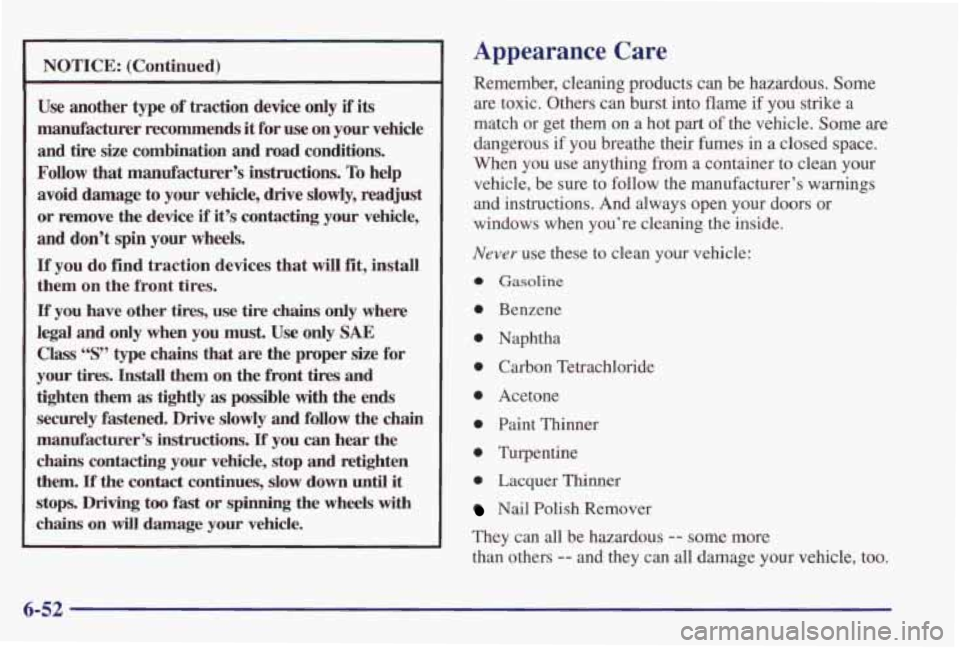
.~
NOTICE: (Continued)
Use another type of traction device only if its
manufacturer recommends it for
use on your vehicle
and tire
size combination and road conditions.
Follow that manufacturer’s
instructions. To help
avoid damage to your vehicle, drive slowly, readjust
or remove the device if it’s contacting your vehicle,
and don’t spin
your wheels.
If you do find traction devices that will fit, install
them on the front tires.
If you have other tires, use tire chains only where
legal and only when you
must. Use only SAE
Class “S” type chains that are the proper size for
your
tires. Install them on the front tires and
tighten them
as tightly as possible with the ends
securely fastened. Drive slowly and follow the chain
manufacturer’s instructions.
If you can hear the
chains contacting your vehicle, stop and retighten
them.
If the contact continues, slow down until it
stops. Driving too fast or spinning the wheels with
chains on will damage your vehicle.
Appearance Care
Remember, cleaning products can be hazardous. Some
are toxic. Others can burst into flame if you strike a
match or get them on a hot
part of the vehicle. Some are
dangerous if you breathe their fumes in a closed space.
When you use anything from
a container to clean your
vehicle, be sure to follow the manufacturer’s warnings
and instructions. And always open your doors or
windows when you’re cleaning the inside.
Never use these to clean your vehicle:
a Gasoline
0 Benzene
0 Naphtha
0 Carbon Tetrachloride
0 Acetone
0 Paint Thinner
0 Turpentine
0 Lacquer Thinner
Nail Polish Remover
They can all be hazardous
-- some more
than others -- and they can all damage your vehicle, too.
6-52